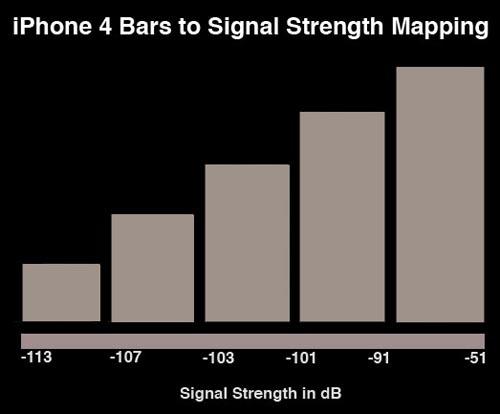
The iPhone 4 signal problems have been a hotly-discussed topic since it was discovered about a week ago. Today we finally have an in-depth analysis of the issue thanks to the folks over at AnandTech. They say that the iPhone 4 performs well inside of a case but can experience a signal drop of up to 20 dB if the device is naked in the hand. Things get even more interesting as the analysis continues: the iOS 4 signal meter uses a highly compressed range, so if you're in an area with a weak signal, that 20 dB drop can take you from four bars down to one. If you have a good reception with five bars, though, that drop won't have any effect on your signal.
As you can see in the chart above, the range from one bar to four goes from -113 dB to -91 dB, but the range between four and five bars is much larger, going from -91 dB to -51 dB. So that 20 dB drop mentioned earlier wouldn't even cause you to lose one bar if you already have five, but if you have four or fewer bars, you're looking at serious signal loss. Still, AnandTech says that the iPhone's improved signal-to-noise ratio helps it to perform better than its predecessors. They continue by saying that "this iPhone gets the best cellular reception yet, even though measured signal is lower than the 3GS."
The iPhone 4 may have the best reception of any iPhone yet, but that doesn't change the fact the antenna issue is still present on some iPhone 4s. If you're experiencing these issues, it seems like a case is your best bet for a solution. We already know that Apple won't be handing out free bumpers, though, so you're on your own if you go that route. AnandTech says that Apple could add an insulative coating to the antenna band to alleviate that issue, so perhaps we'll see some redesigned iPhone 4s in the future. Until then, I'll keep hoping for an iOS update to solve some of the troubles.
Via AnandTech